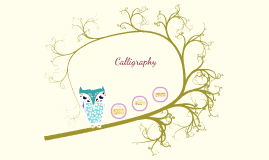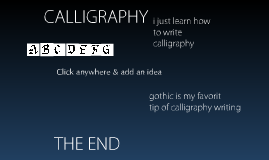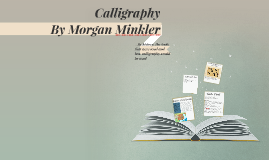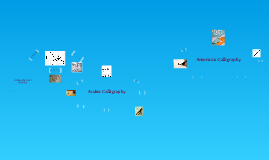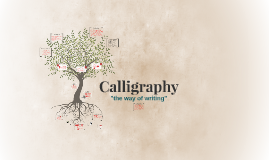Calligraphy
Transcript: Calligraphy Tools: *ruler *eraser *pencil *brushes *calligraphy ink *broad-nibbed dip-pens *craft knife *gouache Calligraphy is often called "beautiful writing." In Europe two sorts of handwriting came into being very early. Cursive script was used for letters and records, while far more polished writing styles, called uncials, were used for literary works. Both styles can be seen in papyrus fragments from the 4th cent. After the 1st cent. the development of the half uncial or minuscule letter from the Roman capital gave rise to an extraordinarily beautiful and long-lasting calligraphy. By the late 16th cent., with the secure establishment of the printing press, the art of calligraphy declined generally throughout Europe. Penmanship of a relatively inferior sort was taught in elementary schools in England and in the United States until the late 19th cent. The 20th cent. has experienced a revival of interest in the art, influenced by the work of Owen Jones and William Morris. Fine calligraphy is currently taught in art and craft schools and is exhibited in museums. Arabic Calligraphy: Chinese Calligraphy: The Chinese Brush Calligraphy is one of the traditional four arts which was once an important critical standard for the Chinese literati in the imperial era and now prevails not only in China but also worldwide as a unique branch of art. Chinese Calligraphy is so abstract and sublime that in Chinese culture it is universally regarded to be the most revealing power of a person. While one has conformed to the defined structure of words, the expression can be displayed with great creativity by individuals. Japanese Calligraphy: Japanese calligraphy is maybe the most artistic type of writing known to man. This is how the Japanese used to write in their local language. Among the best known of these masters were Matteo Contugi, Gianrinaldo Mennio, and Pierantonio Sallando. Alphabet design became a subject of study, and several technical treatises were published on writing styles. By the late 16th cent., with the secure establishment of the printing press, the art of calligraphy declined generally throughout Europe. Penmanship of a relatively inferior sort was taught in elementary schools in England and in the United States until the late 19th cent. The 20th cent. has experienced a revival of interest in the art, influenced by the work of Owen Jones and William Morris. Calligraphy now: Calligraphy continues to flourish in the forms of wedding and event invitations, font design/ typography, original hand-lettered logo design, religious art, various announcements/ graphic design/ commissioned calligraphic art, cut stone inscriptions and memorial documents. Also props and moving images for film and television, testimonials, birth and death certificates/maps, and other works involving writing. Calligraphy is the art of forming beautiful symbols by hand and arranging them well.It’s a set of skills and techniques for positioning and inscribing words so they show integrity, harmony, some sort of ancestry, rhythm and creative fire. Western Calligraphy: Western calligraphy is one of the most used forms of calligraphy today. It is mostly used in wedding and event invitations, business cards, religious decorations and in hand lettered business logos. This kind of calligraphy is based on the Latin alphabet ands a bit of Greek and Cyrillic forms. It was first done by reeds which were later replaced by quills. The first distinct style of this form was the Gothic style which was developed by monks who were reproducing the Bible into several copies. Later, an adaptation of this version appeared and was called, the Rotund. These two were majorly used in the 12th century. Styles available were the italic and the roundhand bookhand method which would later become dominant. The Gothic style was used in the making of the first printing press although this would see the decline of calligraphy as an art. Italic & Antiqua Calligraphy Styles: Another form was the Antiqua style which came a bit earlier than the Italic and was developed by the renaissance calligraphers. It was slow and difficult to write and Italic style also developed in Italy during the renaissance was preferred for its simplicity and elegance. The Italics style was originally known as the Corsiva in Italy. In present times, calligraphy in the western world continues to flourish. The art of calligraphy is also practiced with the limited letter alphabet of Arabic. Because the Muslim faith discourages pictorial representation and reveres the Qur'an, the Islamic peoples esteem calligraphy as highly as do those of East Asia. The earliest Islamic calligraphy is found in the beautiful Qur'ans, written with black ink or gold leaf on parchment or paper in formal, angular script. Begun by the 8th cent., this script was fully developed by the 10th. Elaborations, such as foliation, interfacing, and other complexities were invented later, but they are used only for decorative work.






